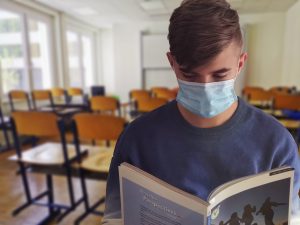Written by Joyce Smith, BS. This study found no substantial difference in the number of COVID-19 cases among students or staff in school districts that implemented a distancing policy of three versus six feet between students, and therefore, does support the return of students to classrooms where physical infrastructure allows for only three feet of distancing.
 In March, 2020 as Severe Acute Respiratory Syndrome Coronvavirus-2 (SARSCoV-2) cases were increasing across the United States, schools across the country were closed, and the vast majority stayed closed for the remainder of the school year 1. This policy decision was based on the data that children and schools may be primary drivers of infection 2. However, since schools were closed, new emerging data suggested that if mitigation measures such as mask wearing and adequate social distancing were implemented, children and schools would no longer be primary drivers of the pandemic 3,4. While the World Health Organization (WHO) has recommended distancing requirements of 3.3 feet, the Centers for Disease Control and Prevention (CDC) has recommended 6 feet, and the American Academy of Pediatrics 3-6 feet 5,6, other countries have established guidelines suggesting that both 3 and 6 feet are acceptable. In the US, the impact of social distancing in schools remains a national policy question 7.
In March, 2020 as Severe Acute Respiratory Syndrome Coronvavirus-2 (SARSCoV-2) cases were increasing across the United States, schools across the country were closed, and the vast majority stayed closed for the remainder of the school year 1. This policy decision was based on the data that children and schools may be primary drivers of infection 2. However, since schools were closed, new emerging data suggested that if mitigation measures such as mask wearing and adequate social distancing were implemented, children and schools would no longer be primary drivers of the pandemic 3,4. While the World Health Organization (WHO) has recommended distancing requirements of 3.3 feet, the Centers for Disease Control and Prevention (CDC) has recommended 6 feet, and the American Academy of Pediatrics 3-6 feet 5,6, other countries have established guidelines suggesting that both 3 and 6 feet are acceptable. In the US, the impact of social distancing in schools remains a national policy question 7.
As COVID-19 infection rates fell, Massachusetts officials considered ending remote learning and returning school-aged children to the classroom. Inconsistent national and international recommendations prompted Van den Berg and colleagues to conduct the following retrospective analysis 8 that compared incident cases of SARS-CoV-2 in students and staff in Massachusetts public schools in districts where physical distancing requirements differed. Massachusetts state guidance mandated masking for all school staff and for students in grades 2 and higher. The majority of state school districts required universal masking.
The research team examined publicly available data from 251 Massachusetts school districts, encompassing 537,336 students and 99,390 staff who attended in-person instruction during a 16-week study period from September 2020 to January 2021. After analysis, which included multivariable regression modeling of available information, the van den Berg team found no significant differences in the rate of COVID-19 cases among students and staff in districts that mandated six feet of distancing versus in districts that mandated three feet of distancing. The team also noted that physical distancing was only one of several infection prevention measures taken by school districts.
The team’s analysis revealed that the schools investigated generally had lower overall rates of infection than their surrounding communities, lending credence to the idea that in-person learning is not a major driver of the pandemic; however, district rates of COVID-19 infections, particularly among the teaching staff were tightly linked to those of the community. They recommend that lower physical distancing policies can be adopted in school settings with masking mandates without negatively impacting the safety of students or staff. These results should function as a catalyst to bring more students back to classroom learning.
Source: van den Berg, Polly, Elissa M. Schechter-Perkins, Rebecca S. Jack, Isabella Epshtein, Richard Nelson, Emily Oster, and Westyn Branch-Elliman. “Effectiveness of three versus six feet of physical distancing for controlling spread of COVID-19 among primary and secondary students and staff: A retrospective, state-wide cohort study.” Clinical Infectious Diseases (2021).
Posted March 29, 2021.
Joyce Smith, BS, is a degreed laboratory technologist. She received her bachelor of arts with a major in Chemistry and a minor in Biology from the University of Saskatchewan and her internship through the University of Saskatchewan College of Medicine and the Royal University Hospital in Saskatoon, Saskatchewan. She currently resides in Bloomingdale, IL.
References:
- Education Week. Map: coronavirus and school closures in 2019‐2020.
- Cauchemez S, Valleron AJ, Boëlle PY, Flahault A, Ferguson NM. Estimating the impact of school closure on influenza transmission from Sentinel data. Nature. 2008;452(7188):750-754.
- Lewis D. Why schools probably aren’t COVID hotspots. Nature. 2020;587(7832):17.
- Zimmerman KO, Akinboyo IC, Brookhart MA, et al. Incidence and Secondary Transmission of SARS-CoV-2 Infections in Schools. Pediatrics. 2021.
- CDC. Operating schools during COVID-19: CDC’s Considerations. 2020.
- American Academy of Pediatrics. COVID-19 Guidance for Safe Schools. 2019; https://services.aap.org/en/pages/2019-novel-coronavirus-covid-19-infections/clinical-guidance/covid-19-planning-considerations-return-to-in-person-education-in-schools/. Accessed March 25, 2020.
- Krishnaratne S, Pfadenhauer LM, Coenen M, et al. Measures implemented in the school setting to contain the COVID-19 pandemic: a scoping review. Cochrane Database Syst Rev. 2020;12:Cd013812.
- van den Berg P, Schechter-Perkins EM, Jack RS, et al. Effectiveness of three versus six feet of physical distancing for controlling spread of COVID-19 among primary and secondary students and staff: A retrospective, state-wide cohort study. Clinical infectious diseases : an official publication of the Infectious Diseases Society of America. 2021.
